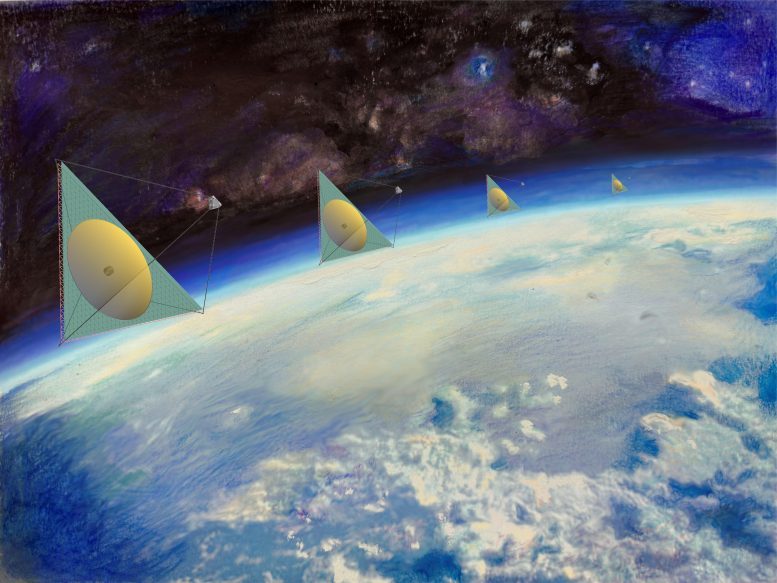
Researchers have developed a new way to make telescope mirrors that could enable much larger, and thus more sensitive, telescopes to be placed in orbit. Credit: Sebastian Rabien, Max Planck Institute for Extraterrestrial Physics
Mirrors that are both lightweight and flexible could be compactly rolled up for the launch, and then accurately reshaped once they are deployed.
Scientists have developed a new method to produce and shape large, high-quality mirrors, significantly thinner than the primary mirrors traditionally employed in space telescopes. These resultant mirrors possess enough flexibility to be rolled up and packed efficiently within a spacecraft during launch.
“Launching and deploying space telescopes is a complicated and costly procedure,” said Sebastian Rabien from Max Planck Institute for Extraterrestrial Physics in Germany. “This new approach — which is very different from typical mirror production and polishing procedures — could help solve weight and packaging issues for telescope mirrors, enabling much larger, and thus more sensitive, telescopes to be placed in orbit.”
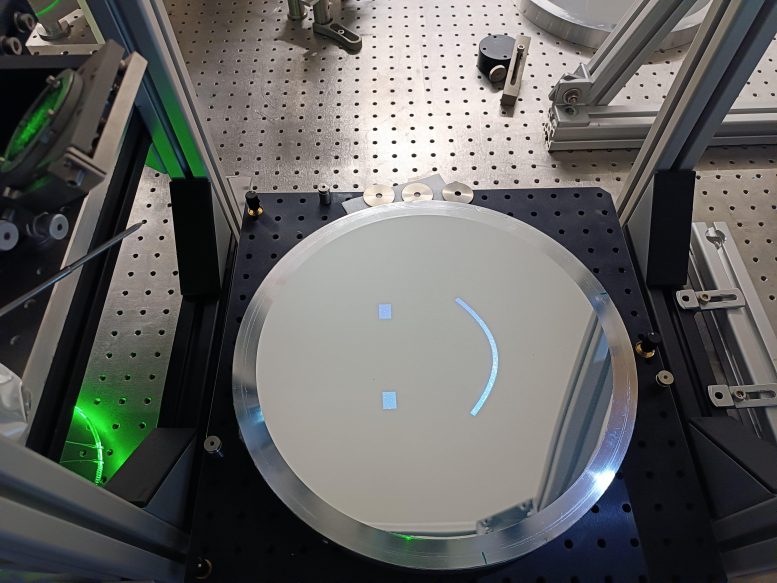
The researchers created the mirrors by using chemical vapor deposition to grow membrane mirrors on a rotating liquid inside a vacuum chamber. This allowed them to form a parabolic thin membrane that can be used as the primary mirror of a telescope once coated with a reflecting surface such as aluminum. Credit: Sebastian Rabien, Max Planck Institute for Extraterrestrial Physics
In the Optica Publishing Group journal Applied Optics, Rabien reports the successful fabrication of parabolic membrane mirror prototypes up to 30 cm in diameter. These mirrors, which could be scaled up to the sizes needed in space telescopes, were created by using chemical vapor deposition to grow membrane mirrors on a rotating liquid inside a vacuum chamber. He also developed a method that uses heat to adaptively correct imperfections that might occur after the mirror is unfolded.
“Although this work only demonstrated the feasibility of the methods, it lays the groundwork for larger packable mirror systems that are less expensive,” said Rabien. “It could make lightweight mirrors that are 15 or 20 meters in diameter a reality, enabling space-based telescopes that are orders of magnitude more sensitive than ones currently deployed or being planned.”
Applying an old process in a new way
The new method was developed during the COVID-19 pandemic, which Rabien says gave him some extra time to think and try out new concepts. “In a long series of tests, we researched many liquids to find out their usability for the process, investigated how the polymer growth can be carried out homogeneously, and worked to optimize the process,” he said.
For chemical vapor deposition, a precursor material is evaporated and thermally split into monomeric molecules. Those molecules deposit on the surfaces in a vacuum chamber and then combine to form a polymer. This process is commonly used to apply coatings such as the ones that make electronics water-resistant, but this is the first time it has been used to create parabolic membrane mirrors with the optical qualities necessary for use in telescopes.
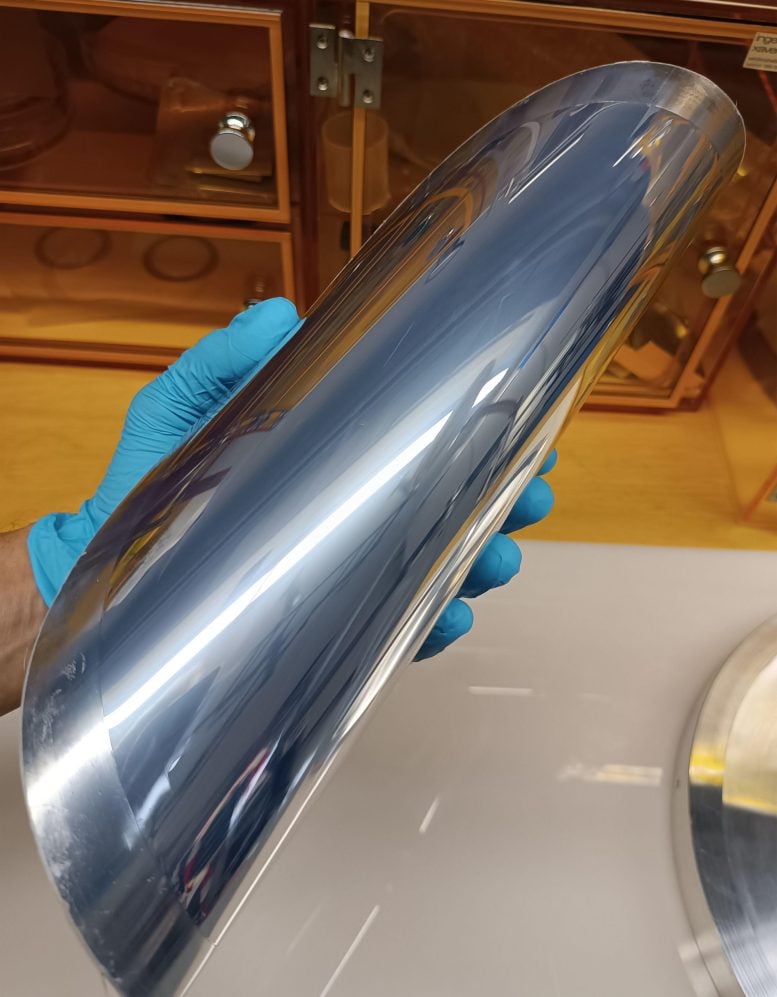
Membrane mirrors made using the new technique are flexible enough to be rolled up. This could be helpful for storing the mirrors inside of a launch vehicle. Credit: Sebastian Rabien, Max Planck Institute for Extraterrestrial Physics
To create the precise shape necessary for a telescope mirror, the researchers added a rotating container filled with a small amount of liquid to the inside of the vacuum chamber. The liquid forms a perfect parabolic shape onto which the polymer can grow, forming the mirror base. When the polymer is thick enough, a reflective metal layer is applied to the top via evaporation and the liquid is washed away.
“It has long been known that rotating liquids that are aligned with the local gravitational axis will naturally form a paraboloid surface shape,” said Rabien. “Utilizing this basic physics phenomenon, we deposited a polymer onto this perfect optical surface, which formed a parabolic thin membrane that can be used as the primary mirror of a telescope once coated with a reflecting surface such as aluminum.”
Although other groups have created thin membranes for similar purposes, these mirrors are typically shaped using a high-quality optical mold. Using a liquid to form the shape is much more affordable and can be more easily scaled up to large sizes.
Reshaping a folded mirror
The thin and lightweight mirror created using this technique can easily be folded or rolled up during the trip to space. However, it would be nearly impossible to get it back to the perfect parabolic shape after unpacking. To reshape the membrane mirror, the researchers developed a thermal method that uses a localized temperature change created with light to enable adaptive shape control that can bring the thin membrane into the desired optical shape.
“It could make lightweight mirrors that are 15 or 20 meters in diameter a reality, enabling space-based telescopes that are orders of magnitude more sensitive than ones currently deployed or being planned.” — Sebastian Rabien
The researchers tested their approach by creating 30-cm diameter membrane mirrors in a vacuum deposition chamber. After much trial and error, they were able to produce high-quality mirrors with a surface shape suitable for telescopes. They also showed that their thermal radiative adaptive shaping method worked well, as demonstrated with an array of radiators and illumination from a digital light projector.
The new membrane-based mirrors could also be used in adaptive optics systems. Adaptive optics can improve the performance of optical systems by using a deformable mirror to compensate for distortion in incoming light. Because the surface of the new membrane mirrors is deformable, these mirrors could be shaped with electrostatic actuators to create deformable mirrors that are less expensive to make than those created with conventional methods.
Next, the researchers plan to apply more sophisticated adaptive control to study how well the final surface can be shaped and how much of an initial distortion can be tolerated. They also plan to create a meter-sized deposition chamber to better study the surface structure and packaging and unfolding processes for a large-scale primary mirror.
Reference: “Adaptive parabolic membrane mirrors for large deployable space telescopes” by Sebastian Rabien, 4 April 2023, Applied Optics.
DOI: 10.1364/AO.487262

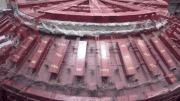
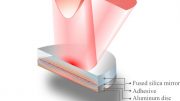
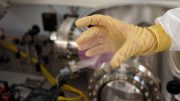


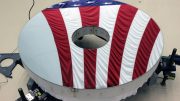
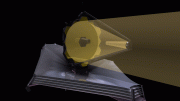
Kept hoping to discover the liquid used. Also, did they ever deposit aluminum reflector? Must use low rate because heat of condensation may distort the membrane.
Couldn’t they also use a “swarm” of small telescopes all networked together (kind of like Elon’s army of Internet satellites or drone armies doing light shows for sports events, only deploying once to create the desired shape) that act as smaller points on a much larger overall “virtual” telescope? Many radio telescopes are often combined to get better readings so why couldn’t they make thousands of small telescopes that deploy and all act as one giant one with each point giving partial data from a much larger radius. Not everything has to be visualized in our visible light spectrum either. Webb is infrared, but it can be converted to our range. So use a Mega Swarm Telescope the size of the moon or something to image distances beyond our imaginations…. Since they’re small, they can be launched by the hundreds or thousands on a Space X rocket. I’m sure there’s some challenges involved, but just imagine a moon sized telescope’s resolving range over huge distances….
Presumably the problem would be in keeping them all aligned
Just Because You Can, Doesn’t Mean You Should..!!!
*Don’t We Have Enough Üp There.??
Figure Out How to Bring Back “Space Junk” Beföre It Eventually Fall’s.
Thank You For Your Time Reading My Thought’s..
R. Tempest from Ont, Canada 🇨🇦